Related Research Articles
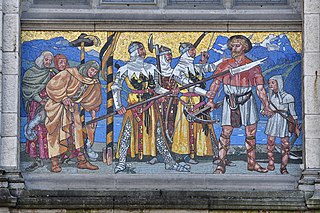
William Tell is a folk hero of Switzerland. According to the legend, Tell was an expert mountain climber and marksman with a crossbow for apple shot and he who assassinated Albrecht Gessler, a tyrannical reeve of the Austrian dukes of the House of Habsburg positioned in Altdorf, in the canton of Uri. Tell's defiance and tyrannicide encouraged the population to open rebellion and a pact against the foreign rulers with neighbouring Schwyz and Unterwalden, marking the foundation of the Swiss Confederacy. Tell was considered the father of the Swiss Confederacy.

The Battle of Sempach was fought on 9 July 1386, between Leopold III, Duke of Austria and the Old Swiss Confederacy. The battle was a decisive Swiss victory in which Duke Leopold and numerous Austrian nobles died. The victory helped turn the loosely allied Swiss Confederation into a more unified nation and is seen as a turning point in the growth of Switzerland.

The Old Swiss Confederacy began as a late medieval alliance between the communities of the valleys in the Central Alps, at the time part of the Holy Roman Empire, to facilitate the management of common interests such as free trade and to ensure the peace along the important trade routes through the mountains. The Hohenstaufen emperors had granted these valleys reichsfrei status in the early 13th century. As reichsfrei regions, the cantons of Uri, Schwyz, and Unterwalden were under the direct authority of the emperor without any intermediate liege lords and thus were largely autonomous.

Augusta Raurica is a Roman archaeological site and an open-air museum in Switzerland located on the south bank of the Rhine river about 20 km east of Basel near the villages of Augst and Kaiseraugst. It is the site of the oldest known Roman colony on the Rhine.

The coat of arms of the Swiss Confederation shows the same white-on-red cross as the flag of Switzerland, but on a heraldic shield instead of the square field.
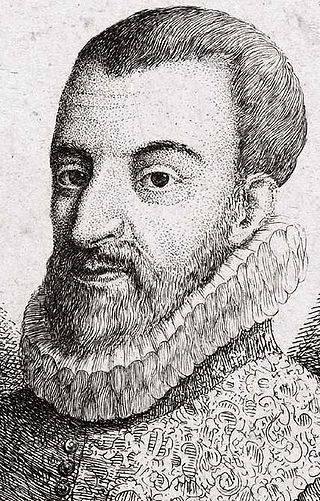
AegidiusTschudi was a Swiss statesman and historian, an eminent member of the Tschudi family of Glarus, Switzerland. His best-known work is the Chronicon Helveticum, a history of the early Swiss Confederation.

The Historical Dictionary of Switzerland is an encyclopedia on the history of Switzerland. It aims to present the history of Switzerland in the form of an encyclopaedia, published both on paper and on the internet, in three of the country's national languages: German, French and Italian. When it was completed at the end of 2014, the paper version contained around 36,000 articles divided into thirteen volumes. At the same time, a reduced edition of the dictionary has been published in Romansh under the title Lexicon istoric retic (LIR), and constitutes the first specialist dictionary in the Rhaeto-Romance, Switzerland.

Melchior Russ was a Swiss historian.
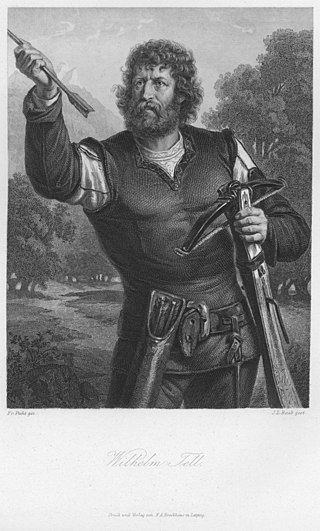
William Tell is a drama written by Friedrich Schiller in 1804. The story focuses on the legendary Swiss marksman William Tell as part of the greater Swiss struggle for independence from the Habsburg Empire in the early 14th century. Gioachino Rossini's four-act opera Guillaume Tell was written to a French adaptation of Schiller's play.
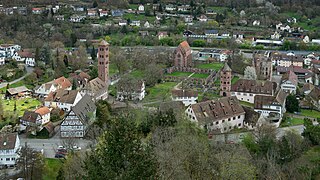
Hirsau Abbey, formerly known as Hirschau Abbey, was once one of the most important Benedictine abbeys of Germany. It is located in the Hirsau borough of Calw on the northern slopes of the Black Forest mountain range, in the present-day state of Baden-Württemberg. In the 11th and 12th century, the monastery was a centre of the Cluniac Reforms, implemented as "Hirsau Reforms" in the German lands by William of Hirsau. The complex was devastated during the War of the Palatine Succession in 1692 and not rebuilt. The ruins served as a quarry for a period of time.
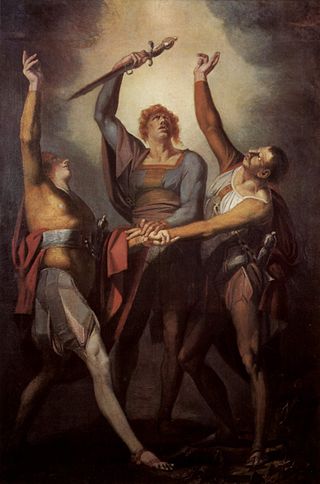
The Rütli Oath is the legendary oath taken at the foundation of the Old Swiss Confederacy by the representatives of the three founding cantons, Uri, Schwyz and Unterwalden, It is named after the site of the oath taking, the Rütli, a meadow above Lake Uri near Seelisberg. Recorded in Swiss historiography from the 15th century, the oath is notably featured in the 19th century play William Tell by Friedrich Schiller.

The White Book of Sarnen is a collection of medieval manuscripts compiled in the late 15th century by Hans Schriber, state secretary (Landschreiber) in the Swiss Confederation canton Obwalden. This volume, 258 pages in length, was given its name because of the white parchment in which it is bound. The White Book of Sarnen contains the earliest surviving reference to the Swiss national hero William Tell.
The Bundeslied or Tellenlied is a patriotic song of the Old Swiss Confederacy. Its original composition dates to the Burgundian Wars period (1470s). The oldest extant manuscript text was written in 1501, the first publication in print dates to 1545. It consists of stanzas of six lines each, with a rhyming scheme of A-A-B-C-C-B. It is one of the oldest existing records of the legend of Swiss national hero William Tell.
The Chronicle of the City of Lucerne is the oldest existing chronological account of the history of the city of Lucerne.

The Chronicle of the Swiss Confederation is the oldest printed chronicle of Switzerland. The Chronicle of the Swiss Confederation was written by Petermann Etterlin’s from Lucerne. According to the Swiss historian Jean-François Bergier, Etterlin decided to compose a chronicle on the history of the city of Lucerne towards the end of his life, between 1505 and 1507. Etterlin’s chronicle, which was printed for the first time in 1507 by Michael Furter, is considered to be the earliest surviving printed version of the William Tell story.
The Urner Tellspiel is the earliest surviving written version of a William Tell play.

The historiography of Switzerland is the study of the history of Switzerland.

Agnes of Austria was Queen of Hungary by marriage to Andrew III of Hungary.

Shooting an apple off one's child's head, also known as apple-shot is a feat of marksmanship with a bow that occurs as a motif in a number of legends in Germanic folklore. In the Stith Thompson Motif Index it is F661.3, described as "Skillful marksman shoots apple from man's head" or "apple shot from man's head", though it always occurs in the form of the marksman being ordered to shoot an apple off his own son's head. It is best known as William Tell's feat.
In legend and in the early historiography of Switzerland there is an account of a migration of a population of Swedes and Frisians settling in the Swiss Alps, specifically in Schwyz and in Hasli (Schwedensage).
References
- Bergier, Jean-François. Wilhelm Tell: Realität und Mythos. München: Paul List Verlag, 1990.
- Potter, G. R. The English Historical Review 85.335 (1970): 393.
- Stump, Philipp, H. Speculum 70.1 (1995): 215–217.
- Tell Museum. Führer durch das Tell-Museum in Bürglen am Klausenpass.